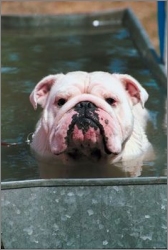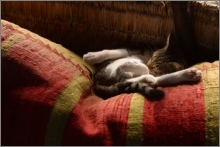How to Bathe Your Pet Properly -- and What NOT to Do
by www.SixWise.com
Knowing when to bathe your pet can seem like one giant guessing game. Unlike humans, pets do not need to be bathed every day or every other day, and they can't hop into the shower when they feel it's time to freshen up.
|

Most dogs only need to be bathed once a month or less -- and it's best to bathe them less often than too often.
|
There are some standard guidelines you can go by though. Cats actually do not need to be bathed at all, unless they have skin problems (such as fleas, ticks or dermatitis) or have gotten into something very dirty.
Dogs, meanwhile, can be bathed up to once a week, but once a month, or even once every three months, is usually plenty. In fact, the most common reason people decide to give their dogs a bath is because they've rolled in something smelly. The dog's breed, age and length of coat all impact how often they need a bath, but signs it's time include obvious dirt or an offensive smell.
Pet Bathing Essentials
For both dogs and cats, you should choose a very mild shampoo that's made for pets. Human and pet shampoos vary in their "pH" (the measure of acidity or alkalinity). A dog shampoo's pH is two points different from a human shampoo, which makes a major difference. Human shampoos are generally too harsh for pets and can easily dry out their coat and skin. Look for one made from all-natural ingredients.
Next, brush or comb your dog or cat before and after the bath. Brushing beforehand is essential because it will remove mats and make it much easier to comb your pet after the bath.
If you are going to bathe your cat, you may also want to trim their nails beforehand to minimize your chances of getting scratched.
During the bath, be careful to keep the water out of your pet's ears. Water in the ears is actually one of the most common causes of ear infections in dogs, so if possible place a cotton ball or two in their ears before the bath (and remember to remove them afterward).
Also take care to keep shampoo out of their eyes as this can cause irritation.
|

Because cats groom themselves frequently, they usually don't need baths.
|
After you have shampooed and rinsed, a conditioner can be applied to the coat. Then it's time for the final rinse -- one of the most important parts of bath time. It's essential to rinse very well, as soap residues can irritate your pet's skin, making them itchy or causing them to lick frequently. Once you think you've rinsed enough, it's a good idea to use fresh water and rinse your pet again just to be sure. Keep the water warm but not hot.
Finally, towel dry your pet thoroughly, and make sure they are completely dry before you allow them to go outside (particularly during the winter). Dogs have a tendency to roll around on the ground right after a bath, and a wet dog can easily get dirty again if it rolls around outdoors.
You can use a hairdryer to help dry off your pet, but be sure it is on the low/warm/cool setting and don't hold it too close to your pet's skin. Using anything higher could burn your pet or dry out their skin. As an alternative, there are pet hairdryers available that only get as hot as is safe for your pet.
What NOT to do When Bathing Your Pet
|
Keep Fleas and Ticks Away
Safely With All-Natural
"Flea 'n Tick B Gone"
 Regular flea and tick control products contain a dangerous mix of pesticides and chemicals that can harm your pet, your environment, and your family. Regular flea and tick control products contain a dangerous mix of pesticides and chemicals that can harm your pet, your environment, and your family.
All-Natural Flea 'n Tick B Gone is an ideal alternative because it's an enzyme-based formula made naturally from plant resources and is truly safe enough to spray directly onto your dog (or horse!). Plus, you can use it as an entirely non-toxic, insect repellant for your backyard. Just mist the area and you're tick- and bug-free for at least three hours!
Flea 'n Tick B Gone is:
- 100% Pesticide Free and Non-Toxic
- Clinically proven to be highly effective
- A Great Value! Eliminates the need for collars, bombs, foggers, powders, etc., and is economically priced
- Can also be used on bedding and pet areas of the home -- Simply lightly spray in these areas
- Reduces vet and medicinal costs
- Can safely be used as a preventive against fleas and ticks: Regular use can naturally break life cycle of fleas
- Controls/Stops other in-home pests like ants, bees, flies and more
- Reduces risk of infections, dermatitis and itching
- Safely removes fleas, ticks, lice and other pests
Find Out More About Flea 'n Tick B Gone Now!
|
What NOT to do is just as important as what TO do when it comes to your pet's bath. Here is the top list of what to AVOID when bathing your furry friend:
-
Do not bathe your pet too often. This can easily dry out and irritate their skin, leading to itching and other skin problems.
-
Do not use human soaps, shampoos or conditioners on your pets. They can also irritate your pet's skin (even baby shampoos can be too harsh).
-
Do not bathe your cat unless necessary. In general, cats don't need baths. (If they are dirty in one area, you can try wiping them down with a washcloth as an alternative to a full bath.)
-
Do not forget to brush your pet before the bath (as well as after). If you don't brush beforehand, your pet's fur could get severely matted.
-
Do not allow water to enter your pet's ears. This can cause ear infections.
-
Do not leave soap residue behind. Rinse thoroughly to protect your pet's skin.
-
Don't leave your dog wet. Drying your dog thoroughly will keep them cleaner longer, and prevent them from getting chilled.
-
Don't use a hairdryer on a high heat setting, as this could burn your pet.
-
Do not bathe your pet in commercial flea and tick solutions if he has fleas or ticks. Popular products in the flea and tick category have been found to be extremely hazardous, some even containing highly noxious nerve gas. Instead, opt for a natural flea and tick repellant -- like Flea 'n Tick B Gone -- that is effective and SAFE for your pet.
Recommended Reading
How Can Having Pets Improve Your Health? Let Us Count the Ways...
Rescued Pets: What You Need to Know When Adopting a Rescued Pet
Sources
DrLarryPetVet.com
Washington State University